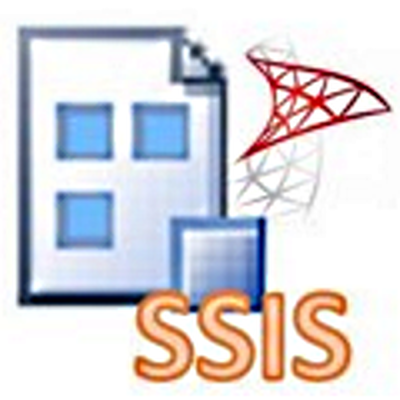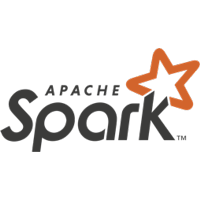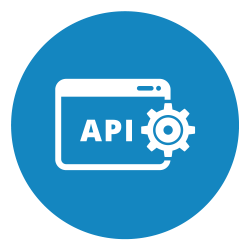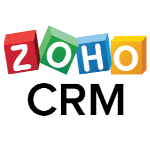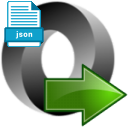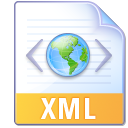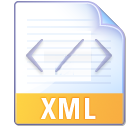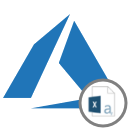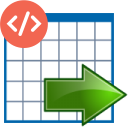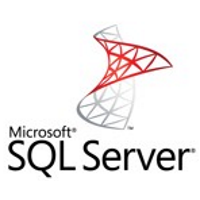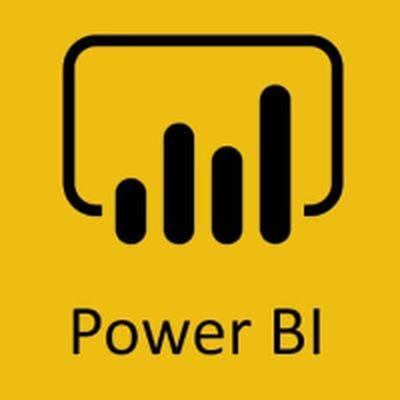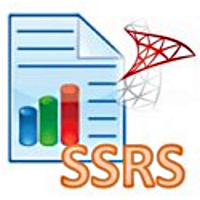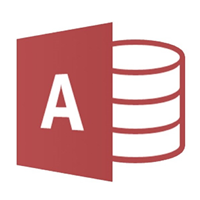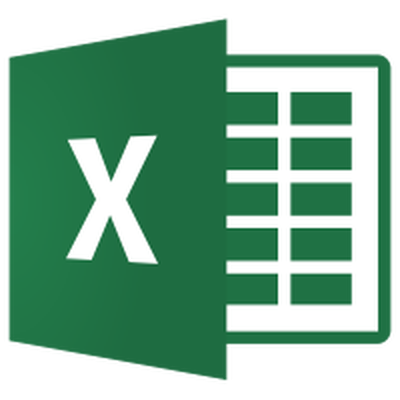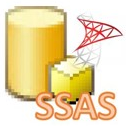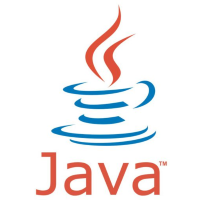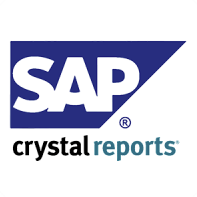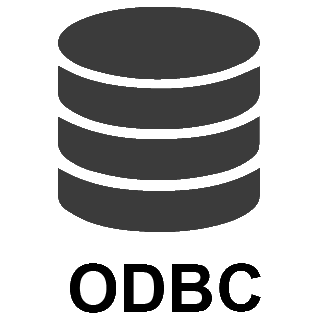Jira Connector for SSISJira Connector can be used to integrate Jira and your defined data source, e.g. Microsoft SQL, Oracle, Excel, Power BI, etc. Get, write, delete Issues, Users, Worklogs, Comments just in a few clicks! In this article you will learn how to quickly and efficiently integrate Jira data in SSIS without coding. We will use high-performance Jira Connector to easily connect to Jira and then access the data inside SSIS. Let's follow the steps below to see how we can accomplish that! Jira Connector for SSIS is based on ZappySys API Connector Framework which is a part of SSIS PowerPack. It is a collection of high-performance SSIS connectors that enable you to integrate data with virtually any data provider supported by SSIS, including SQL Server. SSIS PowerPack supports various file formats, sources and destinations, including REST/SOAP API, SFTP/FTP, storage services, and plain files, to mention a few (if you are new to SSIS and SSIS PowerPack, find out more on how to use them). |
Connect to Jira in other apps
|
Video Tutorial - Integrate Jira data in SSIS
This video covers the following topics and more, so please watch carefully. After watching the video, follow the steps outlined in this article:
- How to download and install the required PowerPack for
Jira integration in SSIS - How to configure the connection for
Jira - Features of the
ZappySys API Source (Authentication / Query Language / Examples / Driver UI) - How to use the
Jira in SSIS
Prerequisites
Before we begin, make sure the following prerequisites are met:
- SSIS designer installed. Sometimes it is referred as BIDS or SSDT (download it from Microsoft).
- Basic knowledge of SSIS package development using Microsoft SQL Server Integration Services.
- SSIS PowerPack is installed (if you are new to SSIS PowerPack, then get started!).
Read data from Jira in SSIS (Export data)
In this section we will learn how to configure and use Jira Connector in API Source to extract data from Jira.
-
Begin with opening Visual Studio and Create a New Project.
Select Integration Service Project and in new project window set the appropriate name and location for project. And click OK.
-
In the new SSIS project screen you will find the following:
- SSIS ToolBox on left side bar
- Solution Explorer and Property Window on right bar
- Control flow, data flow, event Handlers, Package Explorer in tab windows
- Connection Manager Window in the bottom
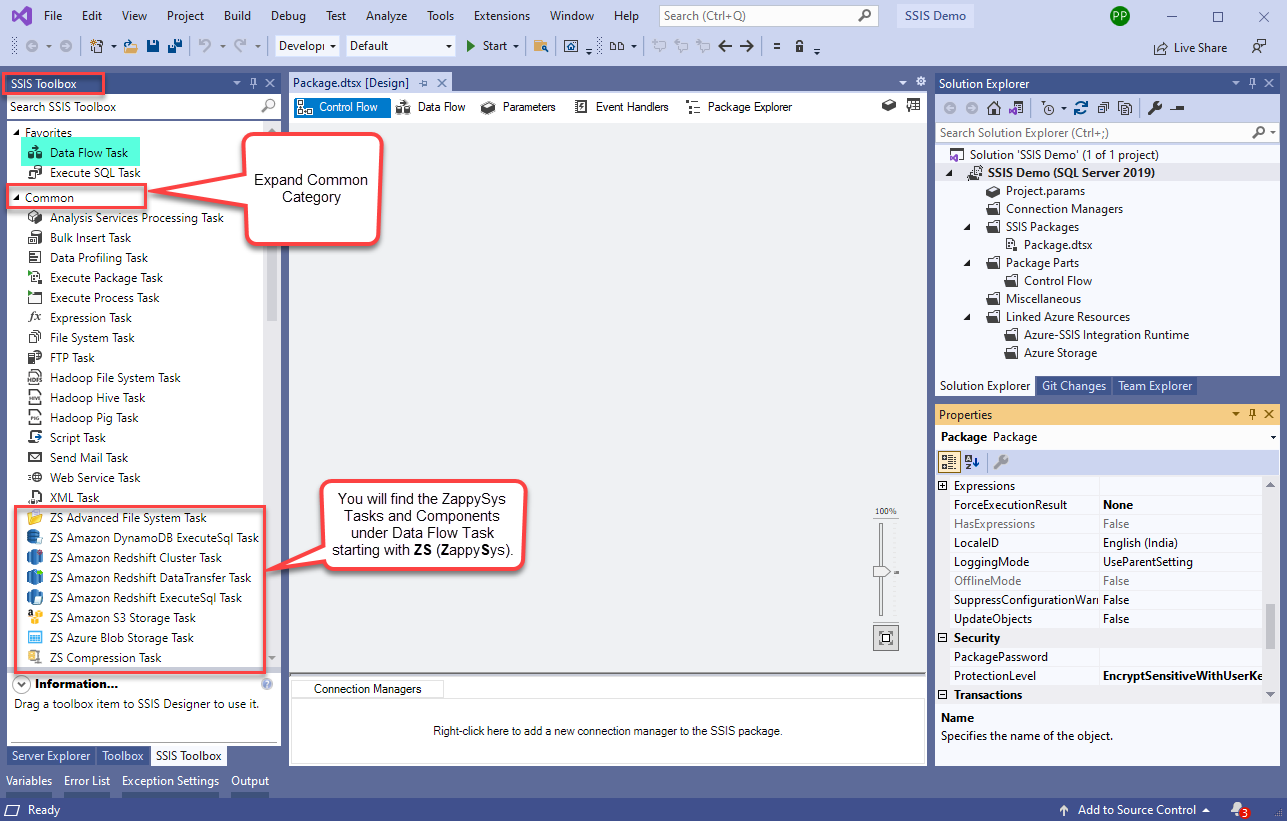 Note: If you don't see ZappySys SSIS PowerPack Task or Components in SSIS Toolbox, please refer to this help link.
Note: If you don't see ZappySys SSIS PowerPack Task or Components in SSIS Toolbox, please refer to this help link. -
Now, Drag and Drop SSIS Data Flow Task from SSIS Toolbox. Double click on the Data Flow Task to see Data Flow designer.
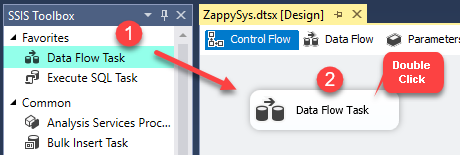
-
From the SSIS toolbox drag and API Source (Predefined Templates) on the data flow designer surface, and double click on it to edit it:
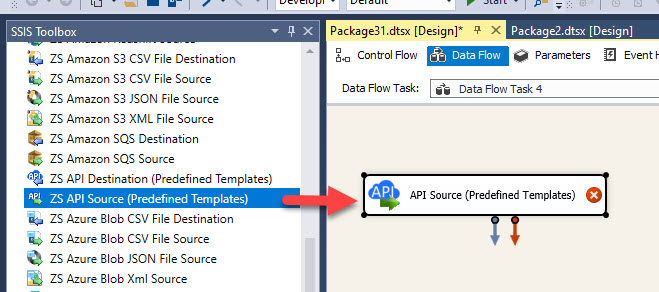
-
Select New Connection to create a new connection:
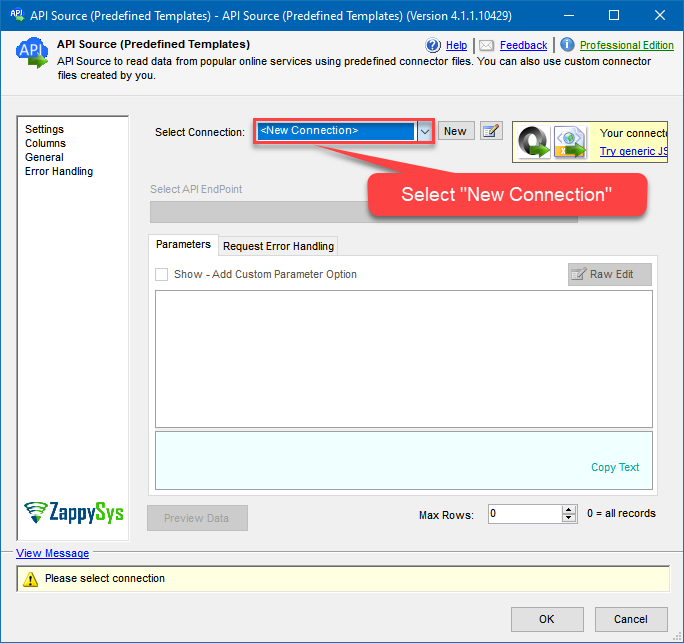
-
Use a preinstalled Jira Connector from Popular Connector List or press Search Online radio button to download Jira Connector. Once downloaded simply use it in the configuration:
Jira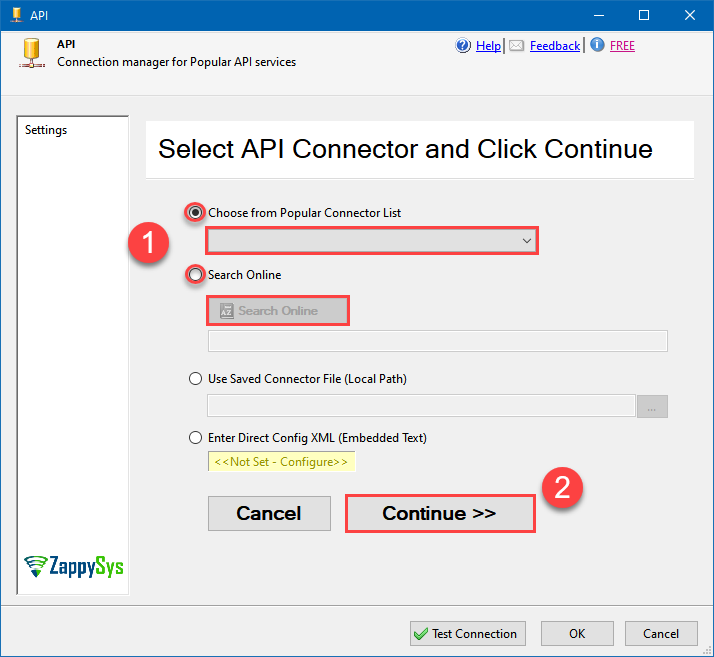
-
Proceed with selecting the desired Authentication Type. Then select API Base URL (in most cases default one is the right one). Finally, fill in all the required parameters and set optional parameters if needed. You may press a link Steps to Configure which will help set certain parameters. More info is available in Authentication section.
Steps how to get and use Jira credentials
Firstly, login into your Atlassian account and then go to your Jira profile:- Go to Profile > Security.
- Click Create and manage API tokens.
- Then click Create API token button and give your token a label.
- When window appears with new API token, copy and use it in this connection manager.
- That's it!
Configuring authentication parameters
JiraAPI Key based Authentication [Http]https://[$Subdomain$].atlassian.net/rest/api/3Required Parameters Subdomain Fill-in the parameter... Atlassian User Name (email) Fill-in the parameter... API Key Fill-in the parameter... Optional Parameters CustomColumnsRegex 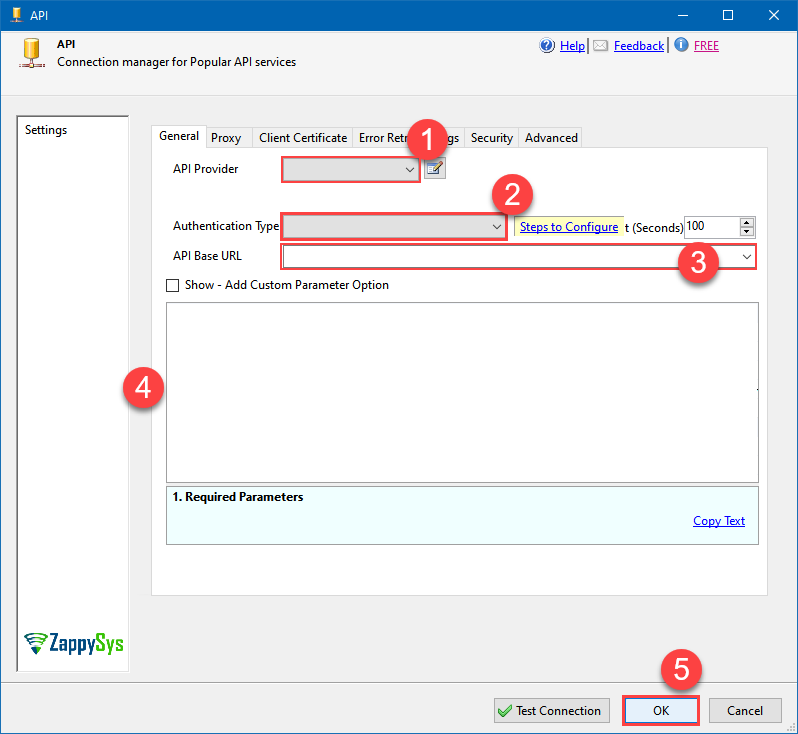 Steps how to get and use Jira credentials
Steps how to get and use Jira credentials
Follow official Atlassian instructions on how to create a PAT (Personal Access Token) for JIRA
Configuring authentication parameters
JiraPersonal Access Token (PAT) Authentication [Http]https://[$Subdomain$].atlassian.net/rest/api/3Required Parameters Subdomain Fill-in the parameter... Token (PAT Bearer Token) Fill-in the parameter... Optional Parameters CustomColumnsRegex 
OAuth App must be created in Atlassian Developer Console. It is found at https://developer.atlassian.com/console/myapps/ [API reference]
Steps how to get and use Jira credentials
Firstly, login into your Atlassian account and then create Jira application:- Go to Atlassian Developer area.
-
Click Create and select OAuth 2.0 integration item to create an OAuth app:
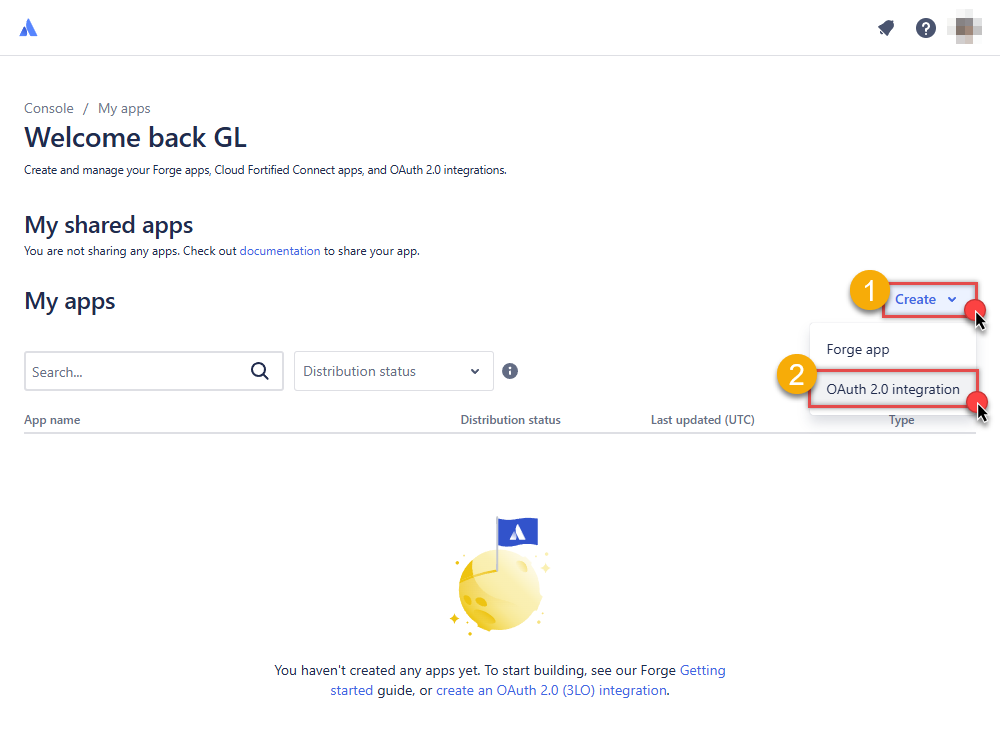
-
Give your app a name, accept the terms and hit Create:
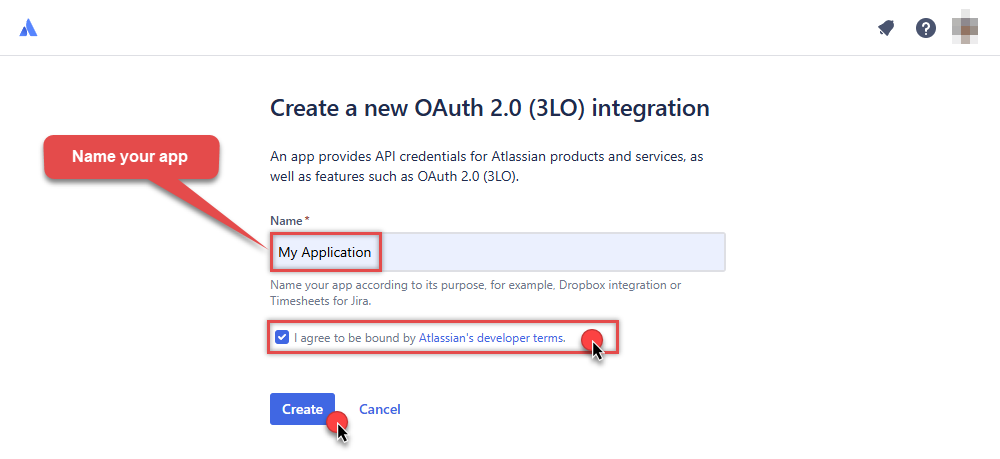
-
To enable permissions/scopes for your application, click Permissions tab, then hit Add button, and click Configure button, once it appears:
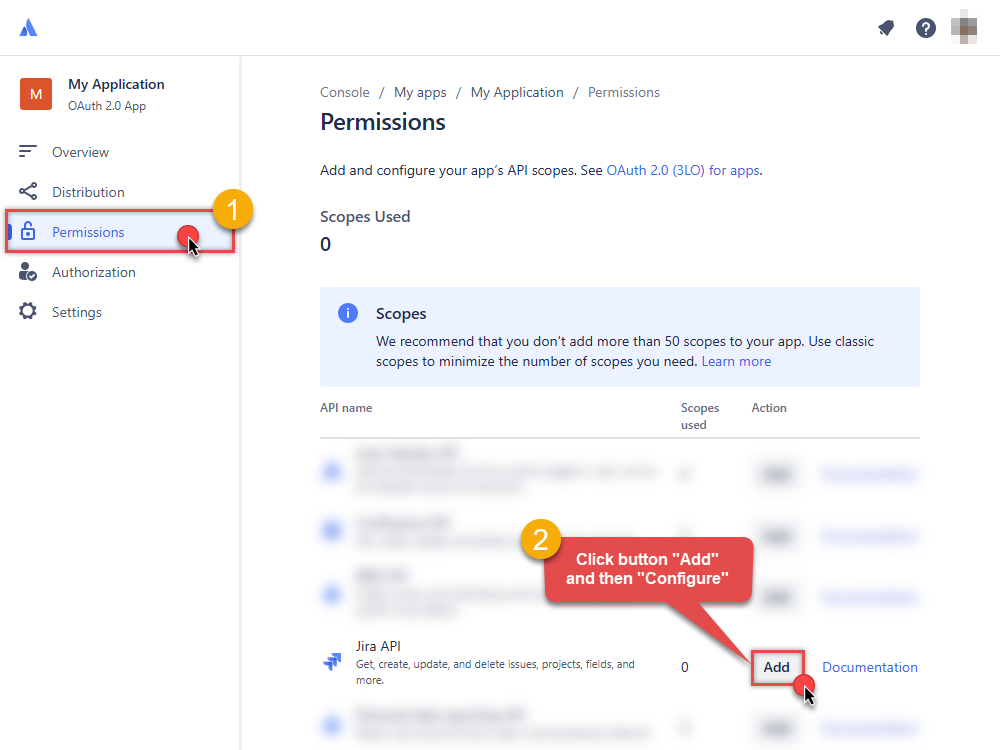
-
Continue by hitting Edit Scopes button to assign scopes for the application:
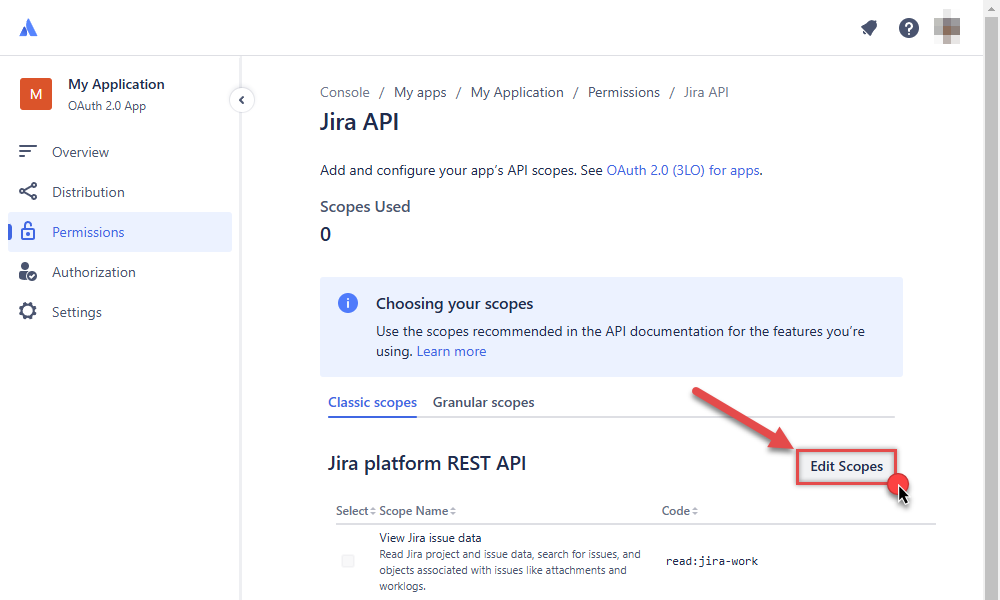
-
Select these scopes or all of them:
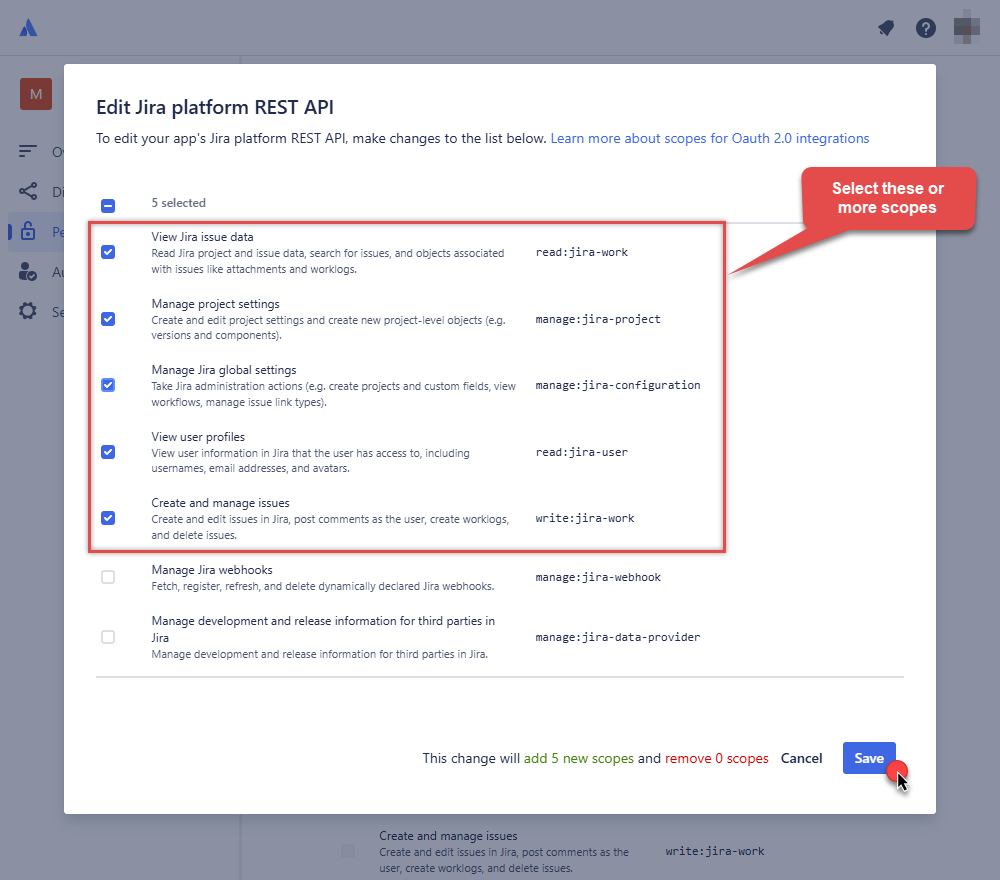
-
Then click Authorization option on the left and click Add button:
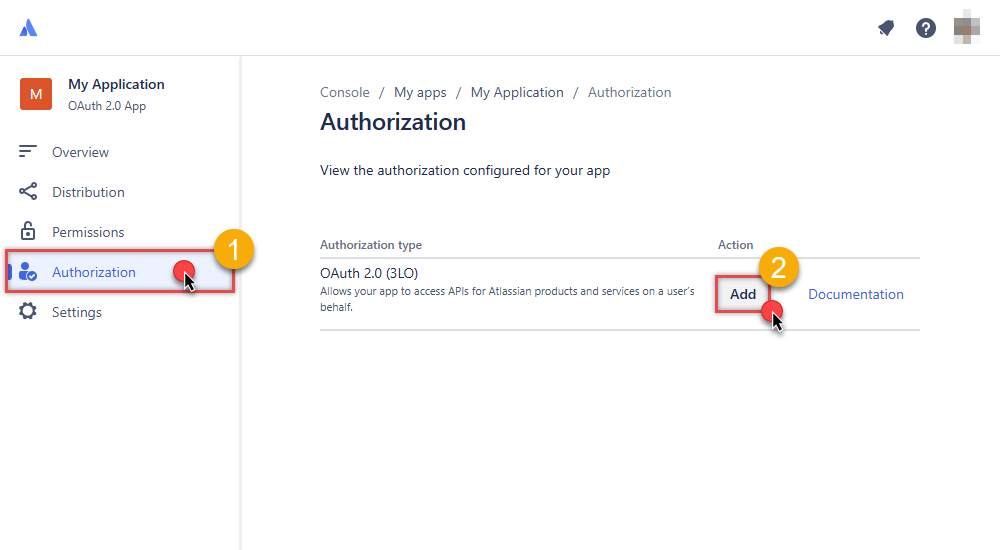
-
Enter your own Callback URL (Redirect URL) or simply enter
https://zappysys.com/oauth, if you don't have one: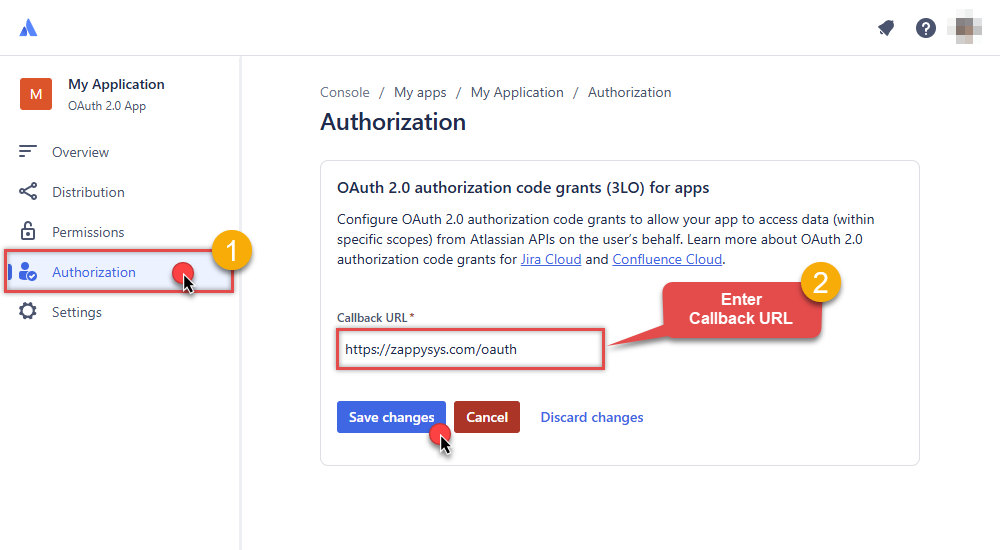
-
Then hit Settings option and copy Client ID and Secret into your favorite text editor (we will need them in the next step):
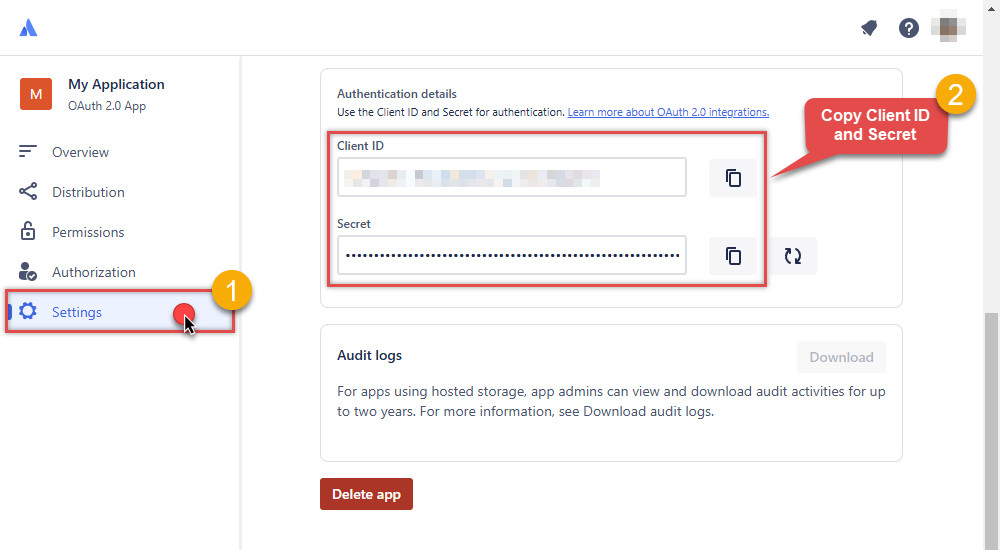
-
Now go to SSIS package or ODBC data source and in OAuth authentication set these parameters:
- For ClientId parameter use Client ID value from the previous steps.
- For ClientSecret parameter use Secret value from the previous steps.
- For Scope parameter use the Scopes you set previously (specify them all here):
- offline_access (a must)
- read:jira-user
- read:jira-work
- write:jira-work
- manage:jira-project
- manage:jira-configuration
NOTE: A full list of available scopes is available in Atlassian documentation. -
For Subdomain parameter use your Atlassian subdomain value
(e.g.
mycompany, if full host name ismycompany.atlassian.net).
- Click Generate Token to generate tokens.
- Finally, select Organization Id from the drop down.
- That's it! You can now use Jira Connector!
Configuring authentication parameters
JiraOAuth (**Must change API Base URL to V3 OAuth**) [OAuth]https://[$Subdomain$].atlassian.net/rest/api/3Required Parameters ClientId Fill-in the parameter... ClientSecret Fill-in the parameter... Scope Fill-in the parameter... ReturnUrl Fill-in the parameter... Organization Id (Select after clicking [Generate Token]) Fill-in the parameter... Optional Parameters Custom Columns for output (Select after clicking [Generate Token]) 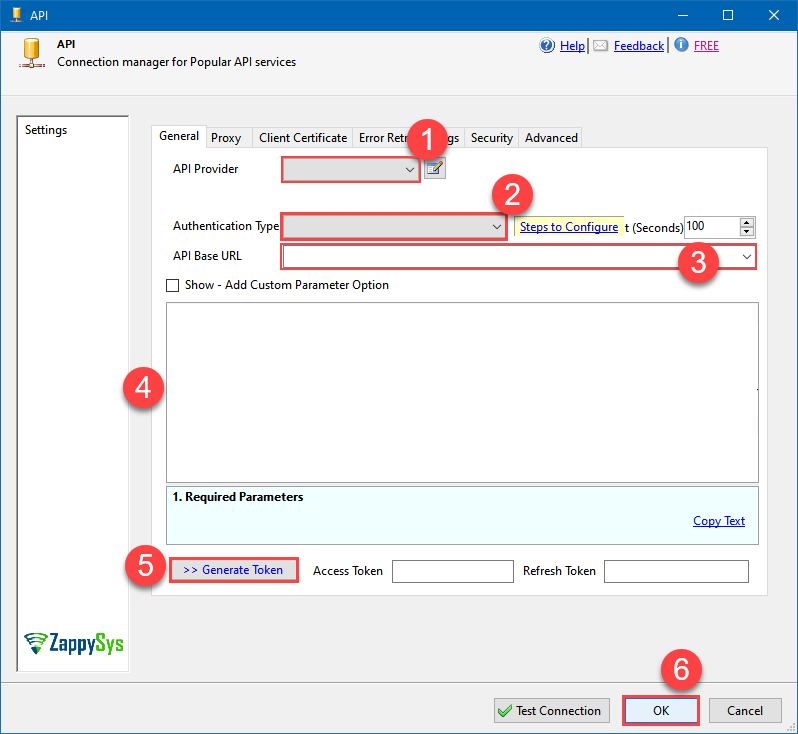
-
Select the desired endpoint, change/pass the properties values, and click on Preview Data button to make the API call.
API Source - JiraJira Connector can be used to integrate Jira and your defined data source, e.g. Microsoft SQL, Oracle, Excel, Power BI, etc. Get, write, delete Issues, Users, Worklogs, Comments just in a few clicks!
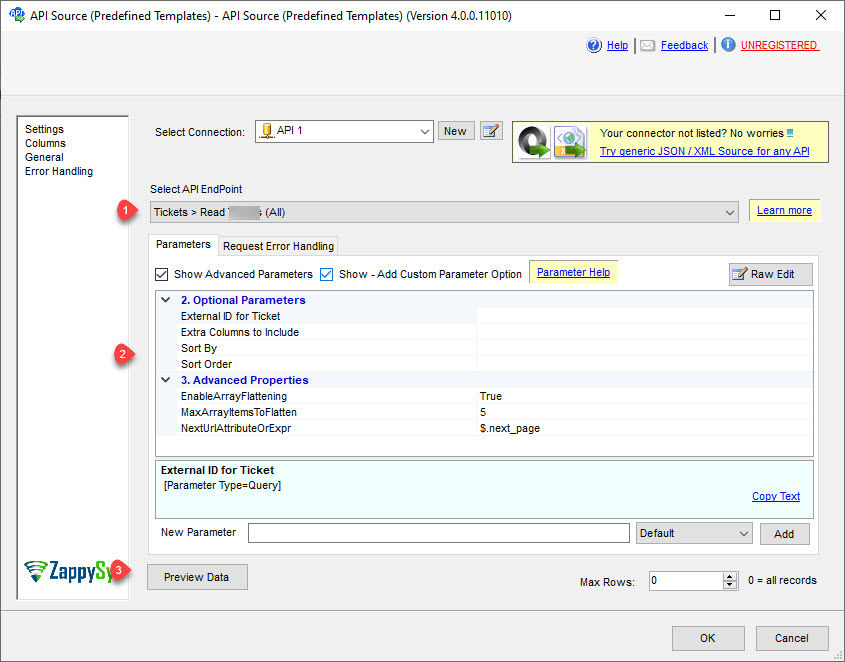
-
That's it! We are done! Just in a few clicks we configured the call to Jira using Jira Connector.
You can load the source data into your desired destination using the Upsert Destination, which supports SQL Server, PostgreSQL, and Amazon Redshift. We also offer other destinations such as CSV, Excel, Azure Table, Salesforce, and more. You can check out our SSIS PowerPack Tasks and components for more options. (*loaded in Trash Destination)
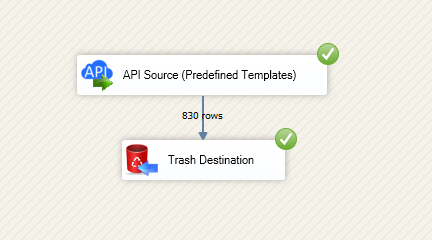
Write data to Jira using SSIS (Import data)
In this section we will learn how to configure and use Jira Connector in the API Destination to write data to Jira.
Video tutorial
This video covers following and more so watch carefully. After watching this video follow the steps described in this article.
- How to download SSIS PowerPack for
Jira integration in SSIS - How to configure connection for
Jira - How to write or lookup data to
Jira - Features about SSIS API Destination
- Using
Jira Connector in SSIS
Step-by-step instructions
In upper section we learned how to read data, now in this section we will learn how to configure Jira in the API Source to POST data to the Jira.
-
Read the data from the source, being any desired source component. In example we will use ZappySys Dummy Data Source component.
-
From the SSIS Toolbox drag and drop API Destination (Predefined Templates) on the Data Flow Designer surface and connect source component with it, and double click to edit it.
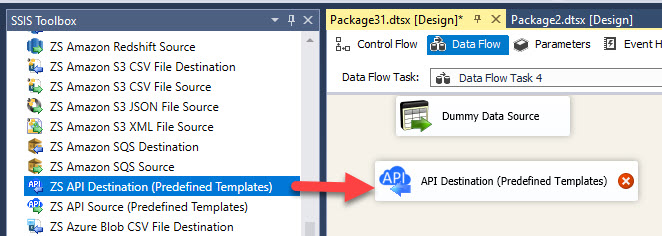
-
Select New Connection to create a new connection:
API Destination - JiraJira Connector can be used to integrate Jira and your defined data source, e.g. Microsoft SQL, Oracle, Excel, Power BI, etc. Get, write, delete Issues, Users, Worklogs, Comments just in a few clicks!
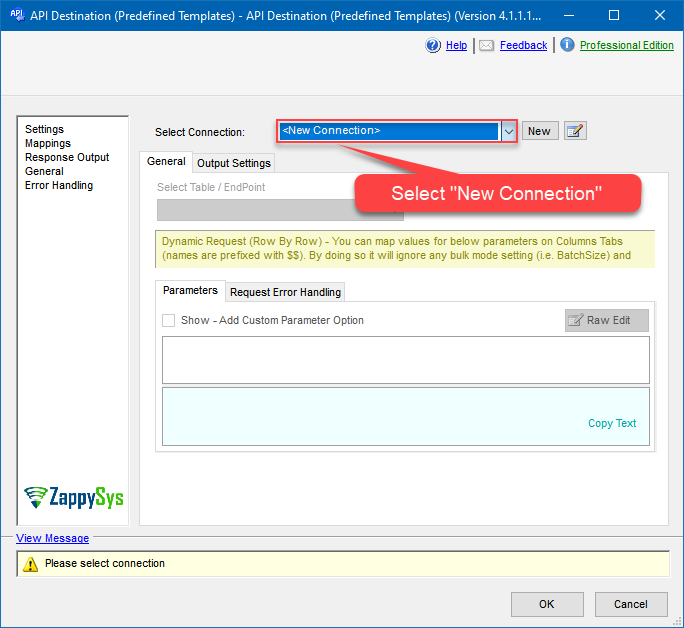
-
Use a preinstalled Jira Connector from Popular Connector List or press Search Online radio button to download Jira Connector. Once downloaded simply use it in the configuration:
Jira
-
Proceed with selecting the desired Authentication Type. Then select API Base URL (in most cases default one is the right one). Finally, fill in all the required parameters and set optional parameters if needed. You may press a link Steps to Configure which will help set certain parameters. More info is available in Authentication section.
Steps how to get and use Jira credentials
Firstly, login into your Atlassian account and then go to your Jira profile:- Go to Profile > Security.
- Click Create and manage API tokens.
- Then click Create API token button and give your token a label.
- When window appears with new API token, copy and use it in this connection manager.
- That's it!
Configuring authentication parameters
JiraAPI Key based Authentication [Http]https://[$Subdomain$].atlassian.net/rest/api/3Required Parameters Subdomain Fill-in the parameter... Atlassian User Name (email) Fill-in the parameter... API Key Fill-in the parameter... Optional Parameters CustomColumnsRegex  Steps how to get and use Jira credentials
Steps how to get and use Jira credentials
Follow official Atlassian instructions on how to create a PAT (Personal Access Token) for JIRA
Configuring authentication parameters
JiraPersonal Access Token (PAT) Authentication [Http]https://[$Subdomain$].atlassian.net/rest/api/3Required Parameters Subdomain Fill-in the parameter... Token (PAT Bearer Token) Fill-in the parameter... Optional Parameters CustomColumnsRegex 
OAuth App must be created in Atlassian Developer Console. It is found at https://developer.atlassian.com/console/myapps/ [API reference]
Steps how to get and use Jira credentials
Firstly, login into your Atlassian account and then create Jira application:- Go to Atlassian Developer area.
-
Click Create and select OAuth 2.0 integration item to create an OAuth app:

-
Give your app a name, accept the terms and hit Create:

-
To enable permissions/scopes for your application, click Permissions tab, then hit Add button, and click Configure button, once it appears:

-
Continue by hitting Edit Scopes button to assign scopes for the application:

-
Select these scopes or all of them:

-
Then click Authorization option on the left and click Add button:

-
Enter your own Callback URL (Redirect URL) or simply enter
https://zappysys.com/oauth, if you don't have one:
-
Then hit Settings option and copy Client ID and Secret into your favorite text editor (we will need them in the next step):

-
Now go to SSIS package or ODBC data source and in OAuth authentication set these parameters:
- For ClientId parameter use Client ID value from the previous steps.
- For ClientSecret parameter use Secret value from the previous steps.
- For Scope parameter use the Scopes you set previously (specify them all here):
- offline_access (a must)
- read:jira-user
- read:jira-work
- write:jira-work
- manage:jira-project
- manage:jira-configuration
NOTE: A full list of available scopes is available in Atlassian documentation. -
For Subdomain parameter use your Atlassian subdomain value
(e.g.
mycompany, if full host name ismycompany.atlassian.net).
- Click Generate Token to generate tokens.
- Finally, select Organization Id from the drop down.
- That's it! You can now use Jira Connector!
Configuring authentication parameters
JiraOAuth (**Must change API Base URL to V3 OAuth**) [OAuth]https://[$Subdomain$].atlassian.net/rest/api/3Required Parameters ClientId Fill-in the parameter... ClientSecret Fill-in the parameter... Scope Fill-in the parameter... ReturnUrl Fill-in the parameter... Organization Id (Select after clicking [Generate Token]) Fill-in the parameter... Optional Parameters Custom Columns for output (Select after clicking [Generate Token]) 
-
Select the desired endpoint, change/pass the properties values, and go to the Mappings tab to map the columns.
API Destination - JiraJira Connector can be used to integrate Jira and your defined data source, e.g. Microsoft SQL, Oracle, Excel, Power BI, etc. Get, write, delete Issues, Users, Worklogs, Comments just in a few clicks!
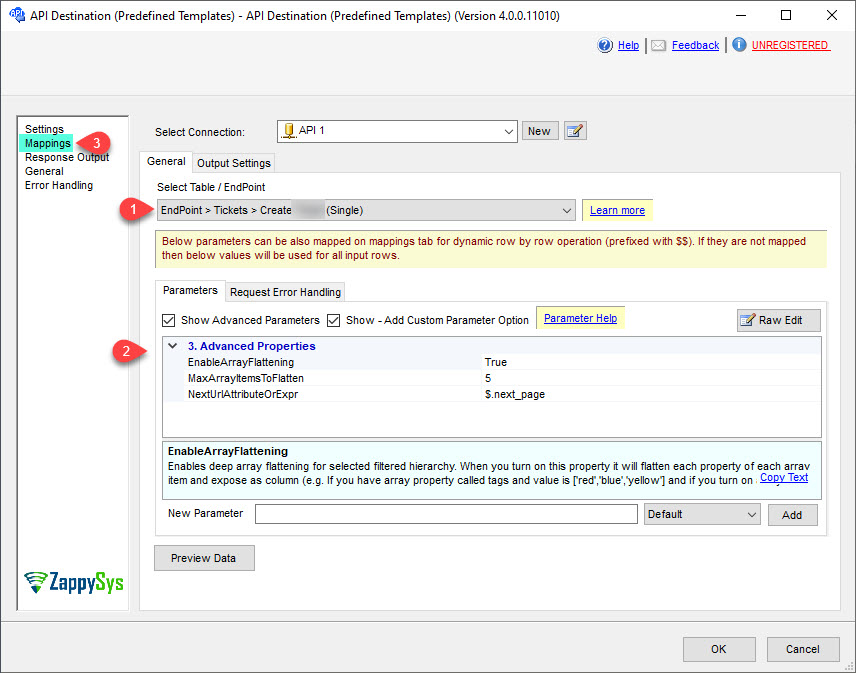
-
Finally, map the desired columns:
API Destination - JiraJira Connector can be used to integrate Jira and your defined data source, e.g. Microsoft SQL, Oracle, Excel, Power BI, etc. Get, write, delete Issues, Users, Worklogs, Comments just in a few clicks!
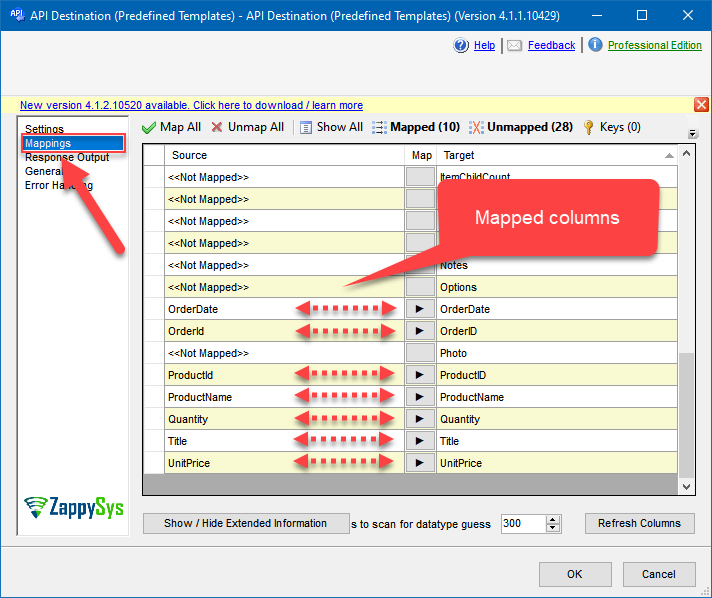
-
That's it; we successfully configured the POST API Call. In a few clicks we configured the Jira API call using ZappySys Jira Connector
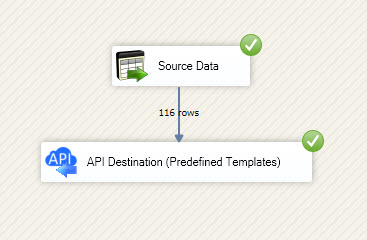
Load Jira data into SQL Server using Upsert Destination (Insert or Update)
Once you configured the data source, you can load Jira data into SQL Server using Upsert Destination.
Upsert Destination can merge or synchronize source data with the target table.
It supports Microsoft SQL Server, PostgreSQL, and Redshift databases as targets.
Upsert Destination also supports very fast bulk upsert operation along with bulk delete.
Upsert operation
- a database operation which performs INSERT or UPDATE SQL commands
based on record's existence condition in the target table.
It
Upsert Destination supports INSERT, UPDATE, and DELETE operations,
so it is similar to SQL Server's MERGE command, except it can be used directly in SSIS package.
-
From the SSIS Toolbox drag-and-drop Upsert Destination component onto the Data Flow designer background.
-
Connect your SSIS source component to Upsert Destination.
-
Double-click on Upsert Destination component to open configuration window.
-
Start by selecting the Action from the list.
-
Next, select the desired target connection or create one by clicking <New [provider] Connection> menu item from the Target Connection dropdown.
-
Then select a table from the Target Table list or click New button to create a new table based on the source columns.
-
Continue by checking Insert and Update options according to your scenario (e.g. if Update option is unchecked, no updates will be made).
-
Finally, click Map All button to map all columns and then select the Key columns to match the columns on:
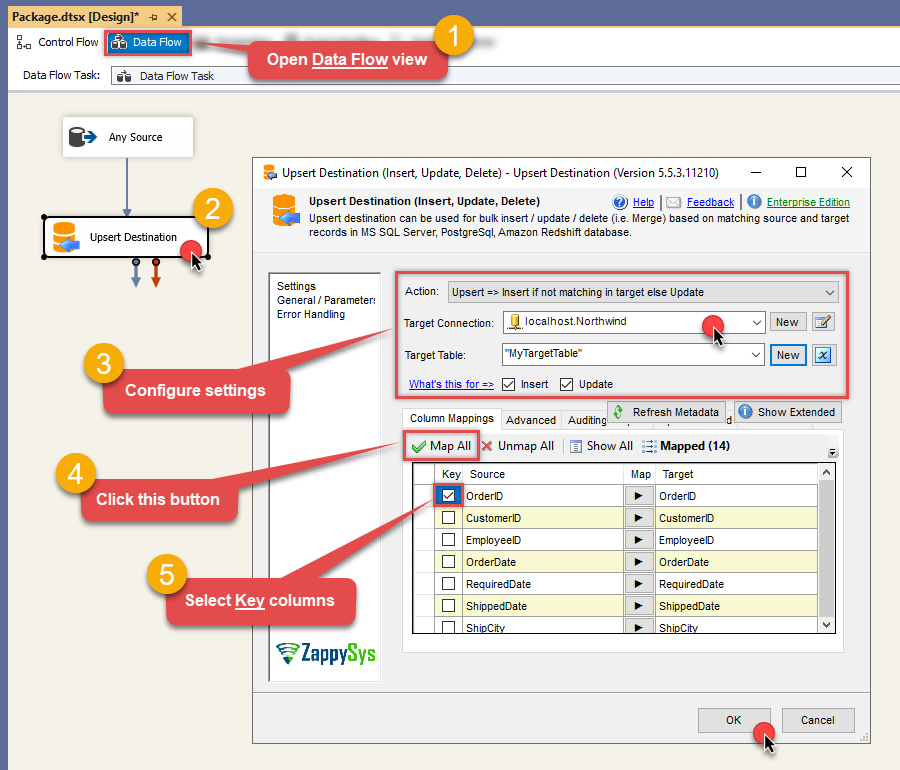
-
Click OK to save the configuration.
-
Run the package and Jira data will be merged with the target table in SQL Server, PostgreSQL, or Redshift:
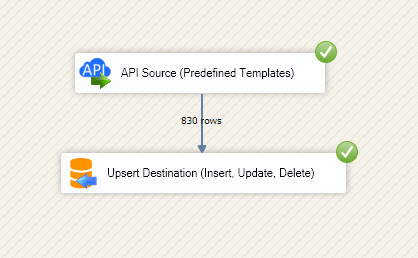
-
Done!
Deploy and schedule SSIS package
After you are done creating SSIS package, most likely, you want to deploy it to SQL Server Catalog and run it periodically. Just follow the instructions in this article:
Running SSIS package in Azure Data Factory (ADF)
To use SSIS PowerPack in ADF, you must first prepare Azure-SSIS Integration Runtime. Follow this link for detailed instructions:
Actions supported by Jira Connector
Jira Connector supports following actions for REST API integration:
Create Issue Comment
Description
Not available.
Parameters
You can provide the following parameters to this action:
-
IssueId Or Key
Input Fields
You can provide the following fields to this action:
-
IssueId -
Body -
BodyFormatted
Output Fields
The following fields are returned after calling this action:
-
Id -
Created -
Updated -
Self -
BodyType -
BodyContent -
BodyContentText -
BodyVersion -
AuthorSelf -
AuthorAccountId -
AuthorEmailAddress -
AuthorAvatarUrls48x48 -
AuthorAvatarUrls24x24 -
AuthorAvatarUrls16x16 -
AuthorAvatarUrls32x32 -
AuthorDisplayName -
AuthorActive -
AuthorTimeZone -
AuthorAccountType -
UpdateAuthorSelf -
UpdateAuthorAccountId -
UpdateAuthorEmailAddress -
UpdateAuthorAvatarUrls48x48 -
UpdateAuthorAvatarUrls24x24 -
UpdateAuthorAvatarUrls16x16 -
UpdateAuthorAvatarUrls32x32 -
UpdateAuthorDisplayName -
UpdateAuthorActive -
UpdateAuthorTimeZone -
UpdateAuthorAccountType -
jsdPublic
Visit documentation for more information.
Create Issues
Description
Not available.
Parameters
You can provide the following parameters to this action:
-
N/A
Input Fields
You can provide the following fields to this action:
-
ProjectId -
ProjectKey -
Summary -
Description -
DescriptionFormatted -
Environment -
EnvironmentFormatted -
IssueTypeId -
IssueTypeName -
AssigneeUserId -
ReporterUserId -
Labels -
DueDate -
[Dynamic Column] -
[Dynamic Column]_value -
[Dynamic Column]_id -
[Dynamic Column]_text
Output Fields
The following fields are returned after calling this action:
-
id -
key -
self
Visit documentation for more information.
Create Project
Description
Not available.
Parameters
You can provide the following parameters to this action:
-
N/A
Input Fields
You can provide the following fields to this action:
-
ProjectKey -
Name -
ProjectTypeKey -
Description -
LeadAccountId -
Url -
AssigneeType -
AvatarId -
IssueSecurityScheme -
PermissionScheme -
NotificationScheme -
CategoryId
Output Fields
The following fields are returned after calling this action:
-
Id -
Key -
Self
Visit documentation for more information.
Create User
Description
Not available.
Parameters
You can provide the following parameters to this action:
-
N/A
Input Fields
You can provide the following fields to this action:
-
Password -
EmailAddress -
DisplayName
Output Fields
The following fields are returned after calling this action:
-
DisplayName -
EmailAddress -
AccountId -
AccountType -
Active -
Locale -
Self -
AvatarUrls48x48 -
AvatarUrls24x24 -
AvatarUrls16x16 -
AvatarUrls32x32
Visit documentation for more information.
Create Worklog
Description
Not available.
Parameters
You can provide the following parameters to this action:
-
IssueIdOrKey
Input Fields
You can provide the following fields to this action:
-
VisibilityType -
VisibilityValue -
Comment -
CommentFormatted -
StartedAt -
TimeSpent -
TimeSpentInSeconds
Output Fields
The following fields are returned after calling this action:
-
Id -
IssueId -
Self -
AuthorSelf -
AuthorAccountId -
AuthorEmailAddress -
AuthorDisplayName -
AuthorIsActive -
AuthorTimeZone -
AuthorAccountType -
CommentFormatted -
Comment -
UpdateAuthorSelf -
UpdateAuthorAccountId -
UpdateAuthorEmailAddress -
UpdateAuthorDisplayName -
UpdateAuthorActive -
UpdateAuthorTimeZone -
UpdateAuthorAccountType -
Created -
Updated -
Started -
TimeSpent -
TimeSpentInSeconds -
AuthorAvatarUrls48x48 -
AuthorAvatarUrls24x24 -
AuthorAvatarUrls16x16 -
AuthorAvatarUrls32x32 -
UpdateAuthorAvatarUrls48x48 -
UpdateAuthorAvatarUrls24x24 -
UpdateAuthorAvatarUrls16x16 -
UpdateAuthorAvatarUrls32x32
Visit documentation for more information.
Delete Issue
Description
Not available.
Parameters
You can provide the following parameters to this action:
-
IssueIdOrKey
Input Fields
You can provide the following fields to this action:
-
Id
Output Fields
The following fields are returned after calling this action:
-
Response
Visit documentation for more information.
Delete Issue Comment
Description
Not available.
Parameters
You can provide the following parameters to this action:
-
IssueId Or Key -
Comment Id
Input Fields
You can provide the following fields to this action:
-
Id -
IssueId
Output Fields
The following fields are returned after calling this action:
-
Response
Visit documentation for more information.
Delete Project
Description
Not available.
Parameters
You can provide the following parameters to this action:
-
ProjectIdOrKey -
EnableUndo
Input Fields
You can provide the following fields to this action:
-
Id
Output Fields
The following fields are returned after calling this action:
-
Response
Visit documentation for more information.
Delete User
Description
Not available.
Parameters
You can provide the following parameters to this action:
-
AccountId
Input Fields
You can provide the following fields to this action:
-
AccountId
Output Fields
The following fields are returned after calling this action:
-
Response
Visit documentation for more information.
Delete Worklog
Description
Not available.
Parameters
You can provide the following parameters to this action:
-
IssueIdOrKey -
WorklogId
Input Fields
You can provide the following fields to this action:
-
Id
Output Fields
The following fields are returned after calling this action:
-
Response
Visit documentation for more information.
Get custom field context options
Description
Returns a paginated list of all custom field option for a context. Options are returned first then cascading options, in the order they display in Jira. OAuth scopes required: read:field.option:jira.
Parameters
You can provide the following parameters to this action:
-
FieldId -
ContextId
Input Fields
You can provide the following fields to this action:
-
N/A
Output Fields
The following fields are returned after calling this action:
-
IsLast -
Id -
Value -
Isdisabled -
OptionId
Visit documentation for more information.
Get custom field contexts
Description
Returns a paginated list list of contexts for a custom field. OAuth scopes required: read:field:jira, read:custom-field-contextual-configuration:jira.
Parameters
You can provide the following parameters to this action:
-
FieldId
Input Fields
You can provide the following fields to this action:
-
N/A
Output Fields
The following fields are returned after calling this action:
-
IsLast -
Id -
Name -
Description -
IsGlobalContext -
IsAnyIssueType
Visit documentation for more information.
Read Application Roles
Description
Not available.
Parameters
You can provide the following parameters to this action:
-
N/A
Input Fields
You can provide the following fields to this action:
-
N/A
Output Fields
The following fields are returned after calling this action:
-
Key -
Name -
Groups -
GroupDetails -
DefaultGroups -
DefaultGroupsDetails -
SelectedByDefault -
Defined -
NumberOfSeats -
RemainingSeats -
UserCount -
UserCountDescription -
HasUnlimitedSeats -
Platform
Visit documentation for more information.
Read Changelog Details
Description
Returns a paginated list of all changelogs and fields updated for an issue sorted by date, starting from the oldest. OAuth scopes required: read:issue-meta:jira, read:avatar:jira, read:issue.changelog:jira.
Parameters
You can provide the following parameters to this action:
-
IssueId Or Key
Input Fields
You can provide the following fields to this action:
-
N/A
Output Fields
The following fields are returned after calling this action:
-
Id -
AuthorSelfURL -
AuthorAccountId -
AuthorEmailAddress -
AvatarUrls48x48 -
AvatarUrls24x24 -
AvatarUrls16x16 -
AvatarUrls32x32 -
AuthorDisplayName -
IsAuthorActive -
AuthorTimeZone -
CreatedDateTime -
Field -
FieldId -
FieldType -
From -
FromString -
To -
ToString
Visit documentation for more information.
Read Changelogs
Description
Returns a paginated list of all changelogs for an issue sorted by date, starting from the oldest. OAuth scopes required: read:issue-meta:jira, read:avatar:jira, read:issue.changelog:jira.
Parameters
You can provide the following parameters to this action:
-
IssueId Or Key
Input Fields
You can provide the following fields to this action:
-
N/A
Output Fields
The following fields are returned after calling this action:
-
Id -
AuthorSelfURL -
AuthorAccountId -
AuthorEmailAddress -
AvatarUrls48x48 -
AvatarUrls24x24 -
AvatarUrls16x16 -
AvatarUrls32x32 -
AuthorDisplayName -
Is AuthorActive -
AuthorTimeZone -
CreatedDateTime -
Items
Visit documentation for more information.
Read Changelogs by IDs
Description
Returns changelogs for an issue specified by a list of changelog IDs. OAuth scopes required: read:issue-meta:jira, read:avatar:jira, read:issue.changelog:jira.
Parameters
You can provide the following parameters to this action:
-
IssueId Or Key -
Comma Separated ChangeLog Ids
Input Fields
You can provide the following fields to this action:
-
N/A
Output Fields
The following fields are returned after calling this action:
-
Id -
AuthorSelfURL -
AuthorAccountId -
AuthorEmailAddress -
AvatarUrls48x48 -
AvatarUrls24x24 -
AvatarUrls16x16 -
AvatarUrls32x32 -
AuthorDisplayName -
IsAuthorActive -
AuthorTimeZone -
CreatedDateTime -
Items
Visit documentation for more information.
Read Comments
Description
Not available.
Parameters
You can provide the following parameters to this action:
-
Issue Key(s) or Ids - Comma Separated (PRJA-10,PRJA-13) -
Search by -
Project -
JQL -
CustomColumnsRegex
Input Fields
You can provide the following fields to this action:
-
N/A
Output Fields
The following fields are returned after calling this action:
-
IssueId -
IssueKey -
Id -
Created -
Updated -
Self -
BodyType -
BodyContent -
BodyContentText -
BodyVersion -
AuthorSelf -
AuthorAccountId -
AuthorEmailAddress -
AuthorAvatarUrls48x48 -
AuthorAvatarUrls24x24 -
AuthorAvatarUrls16x16 -
AuthorAvatarUrls32x32 -
AuthorDisplayName -
AuthorActive -
AuthorTimeZone -
AuthorAccountType -
UpdateAuthorSelf -
UpdateAuthorAccountId -
UpdateAuthorEmailAddress -
UpdateAuthorAvatarUrls48x48 -
UpdateAuthorAvatarUrls24x24 -
UpdateAuthorAvatarUrls16x16 -
UpdateAuthorAvatarUrls32x32 -
UpdateAuthorDisplayName -
UpdateAuthorActive -
UpdateAuthorTimeZone -
UpdateAuthorAccountType -
jsdPublic
Visit documentation for more information.
Read Custom Fields
Description
Not available.
Parameters
You can provide the following parameters to this action:
-
CustomColumnsRegex
Input Fields
You can provide the following fields to this action:
-
N/A
Output Fields
The following fields are returned after calling this action:
-
Id -
Key -
Name -
Custom -
Orderable -
Navigable -
Searchable -
ClauseNames -
SchemaType -
SchemaSystem -
UntranslatedName -
SchemaItems -
SchemaCustom -
SchemaCustomId -
ScopeType -
ScopeProjectId
Visit documentation for more information.
Read Fields
Description
Not available.
Parameters
You can provide the following parameters to this action:
-
N/A
Input Fields
You can provide the following fields to this action:
-
N/A
Output Fields
The following fields are returned after calling this action:
-
Id -
Key -
Name -
Custom -
Orderable -
Navigable -
Searchable -
ClauseNames -
SchemaType -
SchemaSystem -
UntranslatedName -
SchemaItems -
SchemaCustom -
SchemaCustomId -
ScopeType -
ScopeProjectId
Visit documentation for more information.
Read Groups
Description
Not available.
Parameters
You can provide the following parameters to this action:
-
Query -
UserName -
Exclude
Input Fields
You can provide the following fields to this action:
-
N/A
Output Fields
The following fields are returned after calling this action:
-
GroupId -
Name -
Html -
Labels
Visit documentation for more information.
Read Issue Types
Description
Not available.
Parameters
You can provide the following parameters to this action:
-
N/A
Input Fields
You can provide the following fields to this action:
-
N/A
Output Fields
The following fields are returned after calling this action:
-
Id -
Description -
Name -
UntranslatedName -
Subtask -
AvatarId -
HierarchyLevel -
ScopeType -
ScopeProjectId -
IconUrl -
Self
Visit documentation for more information.
Read Issues
Description
Not available.
Parameters
You can provide the following parameters to this action:
-
Search by -
Project -
JQL -
Issue Key(s) or Ids - Comma Separated (PRJA-10,PRJA-13) -
CustomColumnsRegex
Input Fields
You can provide the following fields to this action:
-
N/A
Output Fields
The following fields are returned after calling this action:
-
Id -
Key -
ProjectKey -
ProjectName -
StatusName -
Summary -
Created -
Updated -
Description -
DescriptionFormatted -
CreatorAccountId -
CreatorEmailAddress -
ReporterAccountId -
ReporterEmailAddress -
AssigneeAccountId -
AssigneeEmailAddress -
ResolutionId -
ResolutionDescription -
ResolutionName -
Resolution -
TimespentInSeconds -
DueDate -
Expand -
StatusCategoryChangeDate -
Self -
IssueTypeSelf -
IssueTypeId -
IssueTypeDescription -
IssueTypeIconUrl -
IssueTypeName -
IssueTypeSubtask -
IssueTypeAvatarId -
IssueTypeEntityId -
IssueTypeHierarchyLevel -
ProjectSelf -
ProjectId -
ProjectTypeKey -
ProjectSimplified -
ProjectAvatarUrls48x48 -
ProjectAvatarUrls24x24 -
ProjectAvatarUrls16x16 -
ProjectAvatarUrls32x32 -
FixVersions -
AggregateTimespentInSeconds -
ResolutionDate -
WorkRatio -
WatchesSelf -
WatchesWatchCount -
WatchesIsWatching -
LastViewed -
PrioritySelf -
PriorityIconUrl -
PriorityName -
PriorityId -
Labels -
AggregateTimeOriginalEstimate -
TimeEstimate -
Versions -
IssueLinks -
AssigneeSelf -
AssigneeAvatarUrls48x48 -
AssigneeAvatarUrls24x24 -
AssigneeAvatarUrls16x16 -
AssigneeAvatarUrls32x32 -
AssigneeDisplayName -
AssigneeActive -
AssigneeTimeZone -
AssigneeAccountType -
StatusSelf -
StatusDescription -
StatusIconUrl -
StatusId -
StatusCategorySelf -
StatusCategoryId -
StatusCategoryKey -
StatusCategoryColorName -
StatusCategoryName -
Components -
TimeOriginalEstimate -
DescriptionVersion -
DescriptionType -
Security -
AggregateTimeEstimate -
CreatorSelf -
CreatorAvatarUrls48x48 -
CreatorAvatarUrls24x24 -
CreatorAvatarUrls16x16 -
CreatorAvatarUrls32x32 -
CreatorDisplayName -
CreatorActive -
CreatorTimeZone -
CreatorAccountType -
Subtasks -
ReporterSelf -
ReporterAvatarUrls48x48 -
ReporterAvatarUrls24x24 -
ReporterAvatarUrls16x16 -
ReporterAvatarUrls32x32 -
ReporterDisplayName -
ReporterActive -
ReporterTimeZone -
ReporterAccountType -
AggregateProgressPercent -
AggregateProgressInSeconds -
AggregateProgressTotalInSeconds -
Environment -
EnvironmentFormatted -
ProgressInSeconds -
ProgressTotalInSeconds -
VotesSelf -
Votes -
HasVoted -
ParentId -
ParentKey -
ParentSelf -
ParentSummary -
ParentStatusSelf -
ParentStatusDescription -
ParentStatusIconUrl -
ParentStatusName -
ParentStatusId -
ParentStatusCategorySelf -
ParentStatusCategoryId -
ParentStatusCategoryKey -
ParentStatusCategoryColorName -
ParentStatusCategoryName -
ParentprioritySelf -
ParentpriorityIconUrl -
ParentpriorityName -
ParentpriorityId -
ParentIssueTypeSelf -
ParentIssueTypeId -
ParentIssueTypeDescription -
ParentIssueTypeIconUrl -
ParentIssueTypeName -
ParentIssueTypeSubtask -
ParentIssueTypeAvatarId -
ParentIssueTypeEntityId -
ParentIssueTypeHierarchyLevel -
Assignee -
ResolutionSelf -
[Dynamic Column] -
[Dynamic Column]_value -
[Dynamic Column]_id -
[Dynamic Column]_values -
[Dynamic Column]_text -
[Dynamic Column]_accountId -
[Dynamic Column]_email -
[Dynamic Column]_name
Visit documentation for more information.
Read Projects
Description
Not available.
Parameters
You can provide the following parameters to this action:
-
MaxResults
Input Fields
You can provide the following fields to this action:
-
N/A
Output Fields
The following fields are returned after calling this action:
-
Id -
Key -
Name -
ProjectCategoryId -
ProjectCategoryName -
ProjectCategoryDescription -
ProjectCategorySelf -
Simplified -
Style -
InsightTotalIssueCount -
InsightLastIssueUpdateTime -
AvatarUrls48x48 -
AvatarUrls24x24 -
AvatarUrls16x16 -
AvatarUrls32x32
Visit documentation for more information.
Read Resources
Description
Not available.
Parameters
You can provide the following parameters to this action:
-
N/A
Input Fields
You can provide the following fields to this action:
-
N/A
Output Fields
The following fields are returned after calling this action:
-
Id -
Name -
Url -
Scopes
Visit documentation for more information.
Read Users
Description
Not available.
Parameters
You can provide the following parameters to this action:
-
N/A
Input Fields
You can provide the following fields to this action:
-
N/A
Output Fields
The following fields are returned after calling this action:
-
DisplayName -
EmailAddress -
AccountId -
AccountType -
Active -
Locale -
Self -
AvatarUrls48x48 -
AvatarUrls24x24 -
AvatarUrls16x16 -
AvatarUrls32x32
Visit documentation for more information.
Read Worklogs
Description
Not available.
Parameters
You can provide the following parameters to this action:
-
Issue Key(s) or Ids - Comma Separated (PRJA-10,PRJA-13) -
Search by -
Project -
JQL -
CustomColumnsRegex
Input Fields
You can provide the following fields to this action:
-
N/A
Output Fields
The following fields are returned after calling this action:
-
IssueId -
IssueKey -
Id -
Self -
StartAt -
MaxResults -
Total -
AuthorSelf -
AuthorAccountId -
AuthorEmailAddress -
AuthorDisplayName -
AuthorIsActive -
AuthorTimeZone -
AuthorAccountType -
CommentFormatted -
Comment -
UpdateAuthorSelf -
UpdateAuthorAccountId -
UpdateAuthorEmailAddress -
UpdateAuthorDisplayName -
UpdateAuthorActive -
UpdateAuthorTimeZone -
UpdateAuthorAccountType -
Created -
Updated -
Started -
TimeSpent -
TimeSpentInSeconds -
AuthorAvatarUrls48x48 -
AuthorAvatarUrls24x24 -
AuthorAvatarUrls16x16 -
AuthorAvatarUrls32x32 -
UpdateAuthorAvatarUrls48x48 -
UpdateAuthorAvatarUrls24x24 -
UpdateAuthorAvatarUrls16x16 -
UpdateAuthorAvatarUrls32x32
Visit documentation for more information.
Update Issue
Description
Not available.
Parameters
You can provide the following parameters to this action:
-
IssueIdOrKey -
NotifyUsers -
OverrideScreenSecurity -
OverrideEditableFlag
Input Fields
You can provide the following fields to this action:
-
Id -
ProjectId -
ProjectKey -
Summary -
Description -
DescriptionFormatted -
Environment -
EnvironmentFormatted -
IssueTypeId -
IssueTypeName -
AssigneeUserId -
ReporterUserId -
Labels -
DueDate -
[Dynamic Column] -
[Dynamic Column]_value -
[Dynamic Column]_id -
[Dynamic Column]_text
Output Fields
The following fields are returned after calling this action:
-
body
Visit documentation for more information.
Update Issue Comment
Description
Not available.
Parameters
You can provide the following parameters to this action:
-
IssueId Or Key -
Comment Id
Input Fields
You can provide the following fields to this action:
-
Id -
IssueId -
Body -
BodyFormatted
Output Fields
The following fields are returned after calling this action:
-
Id -
Created -
Updated -
Self -
BodyType -
BodyContent -
BodyContentText -
BodyVersion -
AuthorSelf -
AuthorAccountId -
AuthorEmailAddress -
AuthorAvatarUrls48x48 -
AuthorAvatarUrls24x24 -
AuthorAvatarUrls16x16 -
AuthorAvatarUrls32x32 -
AuthorDisplayName -
AuthorActive -
AuthorTimeZone -
AuthorAccountType -
UpdateAuthorSelf -
UpdateAuthorAccountId -
UpdateAuthorEmailAddress -
UpdateAuthorAvatarUrls48x48 -
UpdateAuthorAvatarUrls24x24 -
UpdateAuthorAvatarUrls16x16 -
UpdateAuthorAvatarUrls32x32 -
UpdateAuthorDisplayName -
UpdateAuthorActive -
UpdateAuthorTimeZone -
UpdateAuthorAccountType -
jsdPublic
Visit documentation for more information.
Update Worklog
Description
Not available.
Parameters
You can provide the following parameters to this action:
-
IssueIdOrKey -
WorklogId
Input Fields
You can provide the following fields to this action:
-
VisibilityType -
VisibilityValue -
Comment -
CommentFormatted -
StartedAt -
TimeSpent -
TimeSpentInSeconds -
Id
Output Fields
The following fields are returned after calling this action:
-
Id -
IssueId -
Self -
AuthorSelf -
AuthorAccountId -
AuthorEmailAddress -
AuthorDisplayName -
AuthorIsActive -
AuthorTimeZone -
AuthorAccountType -
CommentFormatted -
Comment -
UpdateAuthorSelf -
UpdateAuthorAccountId -
UpdateAuthorEmailAddress -
UpdateAuthorDisplayName -
UpdateAuthorActive -
UpdateAuthorTimeZone -
UpdateAuthorAccountType -
Created -
Updated -
Started -
TimeSpent -
TimeSpentInSeconds -
AuthorAvatarUrls48x48 -
AuthorAvatarUrls24x24 -
AuthorAvatarUrls16x16 -
AuthorAvatarUrls32x32 -
UpdateAuthorAvatarUrls48x48 -
UpdateAuthorAvatarUrls24x24 -
UpdateAuthorAvatarUrls16x16 -
UpdateAuthorAvatarUrls32x32
Visit documentation for more information.
Upsert Project
Description
Not available.
Parameters
You can provide the following parameters to this action:
-
ProjectIdOrKey
Input Fields
You can provide the following fields to this action:
-
ProjectKey -
Name -
Description -
LeadAccountId -
Url -
AssigneeType -
AvatarId -
IssueSecurityScheme -
PermissionScheme -
NotificationScheme -
CategoryId
Output Fields
The following fields are returned after calling this action:
-
Id -
Key -
Name -
Description -
IssueTypes -
Expand -
Self -
EntityId -
Uuid -
Properties -
Components -
LeadSelf -
LeadAccountId -
LeadAvatarUrls48x48 -
LeadAvatarUrls24x24 -
LeadAvatarUrls16x16 -
LeadAvatarUrls32x32 -
LeadDisplayName -
LeadActive -
ProjectTypeKey -
AssigneeType -
Versions -
Simplified -
Style -
IsPrivate -
RolesAtlassianAddonsProjectAccess -
RolesAdministrator -
RolesViewer -
RolesMember -
AvatarUrls48x48 -
AvatarUrls24x24 -
AvatarUrls16x16 -
AvatarUrls32x32
Visit documentation for more information.
Make Generic API Request
Description
This is generic endpoint. Use this endpoint when some actions are not implemented by connector. Just enter partial URL (Required), Body, Method, Header etc. Most parameters are optional except URL.
Parameters
You can provide the following parameters to this action:
-
Url -
Body -
IsMultiPart -
Filter -
Headers
Input Fields
You can provide the following fields to this action:
-
N/A
Output Fields
The following fields are returned after calling this action:
-
N/A
Visit documentation for more information.
Make Generic API Request (Bulk Write)
Description
This is a generic endpoint for bulk write purpose. Use this endpoint when some actions are not implemented by connector. Just enter partial URL (Required), Body, Method, Header etc. Most parameters are optional except URL.
Parameters
You can provide the following parameters to this action:
-
Url -
IsMultiPart -
Filter -
Headers
Input Fields
You can provide the following fields to this action:
-
N/A
Output Fields
The following fields are returned after calling this action:
-
N/A
Visit documentation for more information.
Conclusion
In this article we showed you how to connect to Jira in SSIS and integrate data without any coding, saving you time and effort.
We encourage you to download Jira Connector for SSIS and see how easy it is to use it for yourself or your team.
If you have any questions, feel free to contact ZappySys support team. You can also open a live chat immediately by clicking on the chat icon below.
Download Jira Connector for SSIS Documentation

